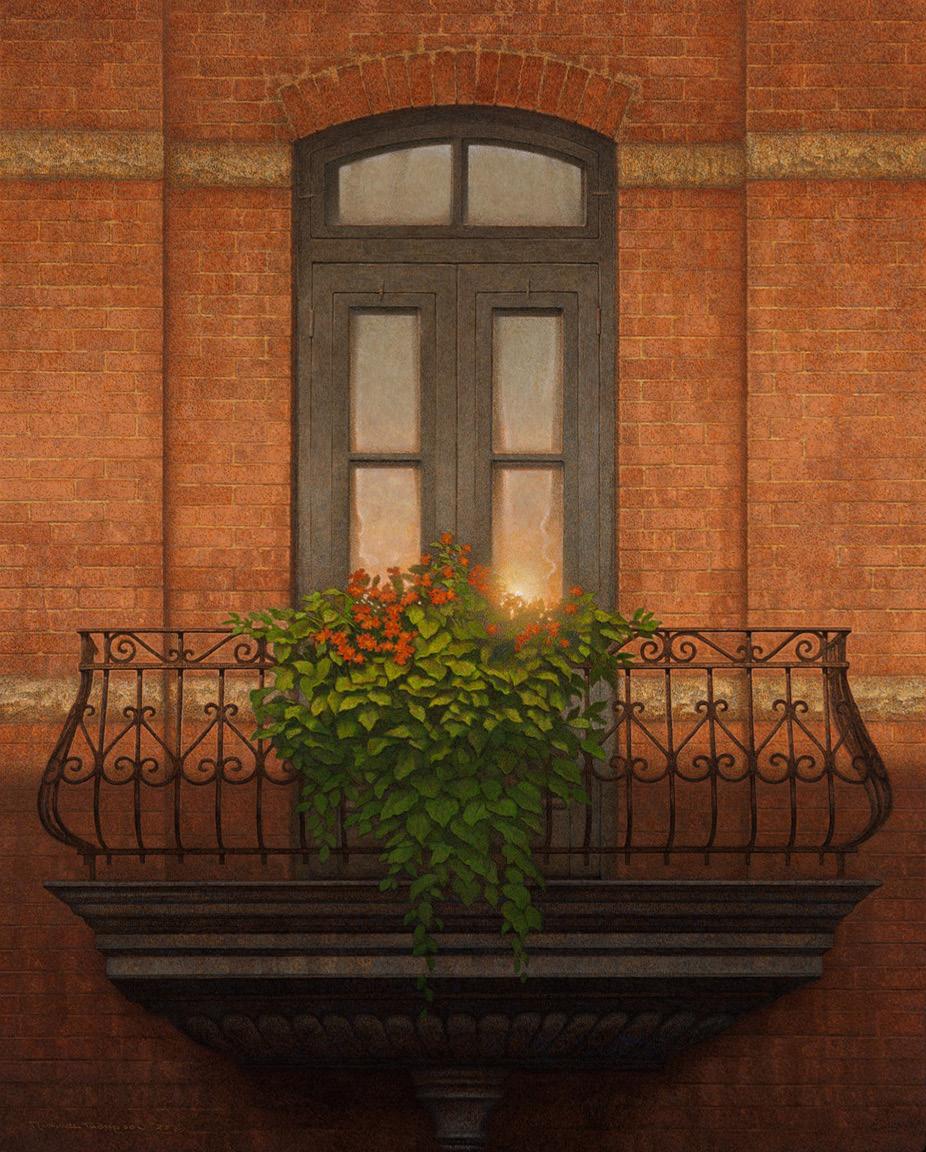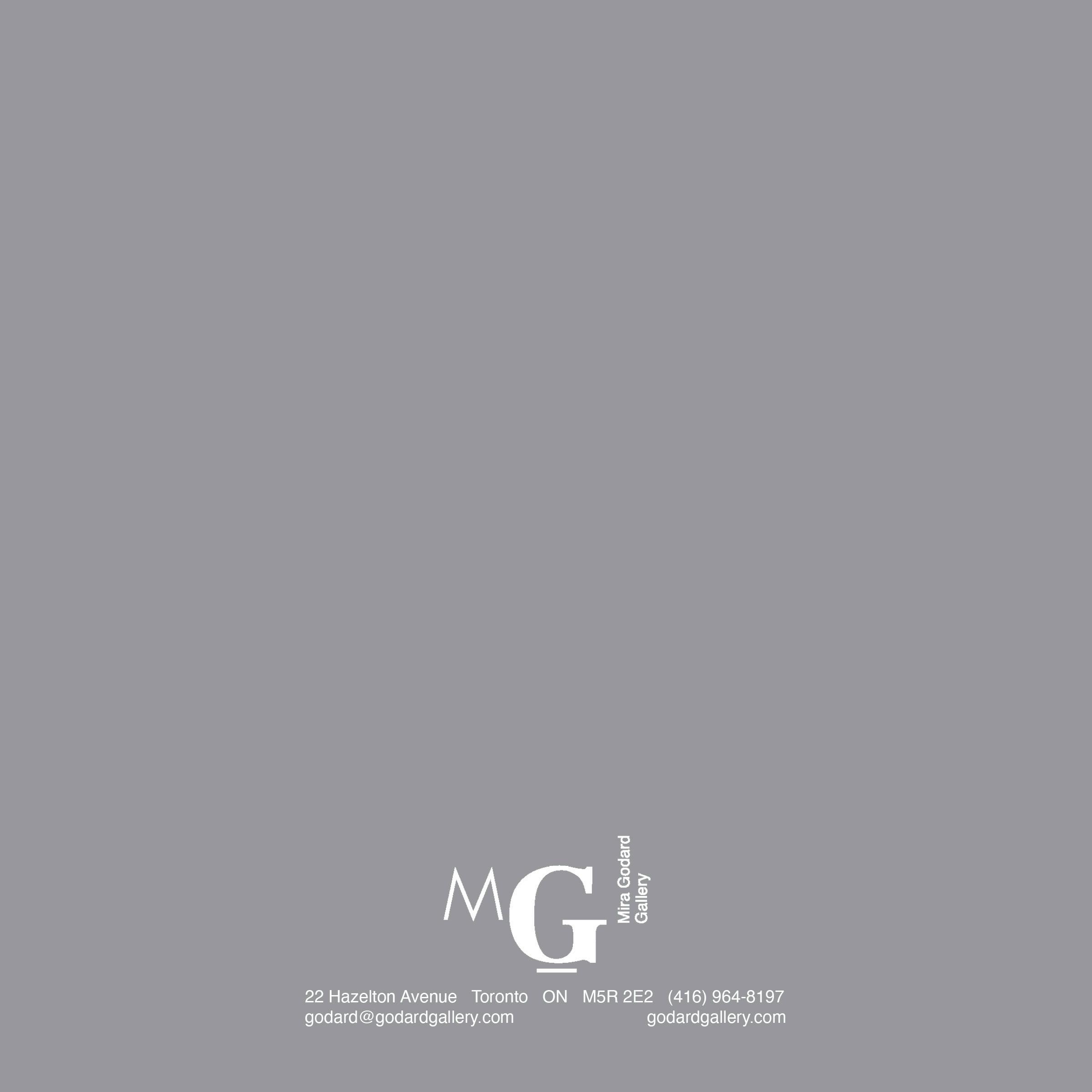

Approximately fifty years ago I left the city of my birth, Montréal, where I had also spent my formative years. At that time, little did I know that the Montreal of my youth would continue to be a direct and indirect influence on the artwork I would subsequently produce in my new found home.
This exhibition is a personal meditation on the ephemeral nature of experience and, as well, the persistence of memory. Although the paintings in this exhibition are of recognizable locations, just like memory itself, there is a great deal of orchestration of the image that takes place; additions and deletions, descriptions and distortions that all serve the greater reality of the mind.
It is my assertion that the measure of a successful painting is not only in its ability to convey surface description but, more importantly, a painting’s ability to access and express the intangibles hidden beneath the surface.
Michael Thompson
MICHAEL THOMPSON was born in 1954 in Montreal, Quebec. He studied Fine Arts at Concordia University, Montreal, graduating with a Bachelor of Fine Art in 1976 and a Graduate Degree in Fine Arts in 1978. He began exhibiting in 1978 and is now widely regarded as one of Canada’s foremost realist painters. Over the last five decades he has created a body of work which is remarkable for its clarity of vision, meticulous technique and enigmatic energy.
His work has been exhibited widely in both private and public galleries in Canada and the United States, including large survey exhibitions at the Art Gallery of Hamilton in 1983, the Kitchener-Waterloo Gallery in 1994 and the Art Gallery of Peel in 2007.
Michael Thompson’s personal approach to painting has attracted much critical attention, and his work can be found in major public, corporate and private collections throughout North America including the Art Gallery of Nova Scotia; Art Gallery of Ontario; Beaverbrook Art Gallery, New Brunswick; Edwin A. Ulrich Museum, Wichita, Kansas; McMaster Museum of Art, Hamilton; Musée d’art contemporain de Montréal; Museum London, Ontario; The Rooms Provincial Art Gallery of Newfoundland and Labrador, Vancouver Art Gallery; Davies Ward Phillips and Vineberg; Four Seasons Hotels and Resorts; Gluskin Sheff and Associates and Scotiabank.
Michael Thompson lives and works in Niagara-on-the-Lake, Ontario and is represented exclusively by Mira Godard Gallery.
Michael Thompson’s artist statement and declaration offers a succinct “stock-taking” (his term); what it means to draw from a well of memory and continue to transform it.1 His objective is what painting can do beyond the obvious registration of place and subject.
London was the focus of much of Leon Kossoff’s (British, 1926-2019) work, his bombed cityscapes after WWII, and scenes of day to day human activity in underground train stations, parks and swimming pools. This was not the tourist London – The City to Londoners – but the surrounding and working class areas. He didn’t need to venture too far; everything he wanted was there. It was likewise for Philip Surrey (1910-1990) and his depictions of Montreal and Reginald Marsh’s (American, 1898-1954) New York Bowery scenes – the theatre of humanity as metaphor – and many other painters of the city. Thompson differs in many ways. There is no urban hustle and bustle and yet Montreal continues as a key element in his painting and drawing – directly and indirectly – even though he has lived and worked in Ontario since 1979.
Thompson considered his Montreal roots and upbringing in hindsight, being “unconsciously immersed in the culture of the East End streets and laneways, les ruelles, the blue-collar, historically French-Canadian area. The architecture, in the older parts is mostly late Victorian triplexes and duplexes characterized by wrought-iron staircases and balconies at the front and wooden sheds clad with galvanized sheeting at the back.” He spoke joual, Montreal street French, before he spoke English. Some of these locales appear in works such as Eastend Morning (p. 29) and Lincoln Street Rooftops (p. 43), where he had a studio and the last place he lived before moving to Toronto. Thompson wrote: “This has always been my essential subject matter, even in a painting like Junction Girl (2018, private collection), a young working-class woman from the Junction area of west Toronto
– that is all East End.”
Thompson continues to be drawn to specific locales and not to take on the entire city. One site is L’Hôtel-Dieu – the first hospital established in Montreal and origins dating to 1642 – with Lightning
Strike (p. 17), Snowstorm (L’Hôtel-Dieu) (p. 37), Mount Royal in Spring (p. 21), and Early Morning Garden (p. 23). Another site is the environs and gardens of Le Grand Séminaire de Montréal on Sherbrooke Street West – 5km west of L’Hôtel-Dieu – with A Tangled Garden (p. 13) and Nuns on Sherbrooke Street (pp. 18-19). Le Grand Séminaire is the centre of the Roman Catholic Archdiocese of Montreal, founded in 1840, although its origins date to 1676.2
I will defer the examination of the nature of image and realism in Thompson’s work as I addressed that for his exhibition at the-then Art Gallery of Peel in 2007-08. He continues to work this way, a choice, and how he can register place and “express the intangibles.” In turn, every conversation with Thompson reveals new facets, his personal and painterly entanglements, as the work of other artists is also a well to draw from, which many term “influence.” It’s more than that, otherwise the ‘influenced artist’ would be a copyist and forever chasing the end of a rainbow (an analogy the American art historian George Kubler used in explaining the impossibility of defining style in his 1962 book The Shape of Time). Thompson wrote of artists that he leans towards – not for subject matter or style per se, but what feeds his approach to painting; the French impressionist Camille Pissarro (1830-1903), and the only one to have exhibited in all eight Paris Impressionist exhibitions from 1874 to 1886, the British Pre-Raphaelite John William Waterhouse (1849-1917), known for his paintings of women and subjects drawn from mythology and literature, and the British-Canadian J.E.H. Macdonald (1873-1923), a founding member of the Group of Seven who painted ‘rawer’ landscapes in a ‘postimpressionist-expressionist’ ethos with loose brushstrokes. They were all active in an overlapping time period, yet they could not be more different and distinct. You won’t find Thompson in any of these three artists or the three in Thompson. That would be chasing the rainbow, yet there are subtle and extractable qualities.
1 All Thompson quotes are from correspondence with the author.
A hallmark of Thompson’s paintings is stillness, underscored by mutated tonality and symmetry in horizontal compositions and intimate views such as A Tangled Garden (the title of a 1916 J.E.H. MacDonald painting, but tangled in a different way). The pool reeds, left and right, draw the eye to a gap and the crumbling pool wall. Thompson wrote that “the current incarnation of the pool is antiseptically pristine and restored, as opposed to the ruinously beautiful and neglected location I first discovered in the 70s.” The companion work is Garden at Twilight (p. 27).
2 Earlier paintings of the garden of Le Grand Séminaire and the pool are Les Petites Filles de Saint-Joseph, 1987, and Priests, 1988.
Other works ‘emphasizing stillness’ have distinct orchestrations, and not approached with a single formula. Mount Royal in Spring (p. 21) – a vista composition – has a foreground of bare trees. In the midground is Mount Royal, topped by a row of trees that recede in atmospheric perspective. The eye moves up and down and across through Thompson’s compositional balance and harmony. It is a de facto landscape that barely reveals its city park setting, Fletcher’s Field about 100 metres north of L’Hôtel-Dieu.
Another vista painting, Snowstorm (L’Hôtel-Dieu) (p. 37), depicts a row of bare trees in a ‘dynamic’ angle in the foreground with the horizonal lines of Park Avenue without traffic (again emphasizing stillness) and L’Hôtel-Dieu in the midground. The bands of white snow cover the parkland, the avenue and the roof and cupola of the hospital. At the top of white-grey sky is advancing snow, obscuring the morning sun. While there is more contrast – whites and browns, in comparison to Mount Royal in Spring – Thompson maintains a harmonious balance in capturing the fleeting moment of atmosphere that is constantly changing. This ‘effect’ can be read through the 1933 Jun’ichirō Tanizaki essay In Praise of Shadows, underscoring everyday beauty that is fleeting: “Were the shadows to be banished from [the] corners, the alcove would in that instant revert to mere void.” Although Tanizaki was writing of the stillness of Japanese interiors, Thompson has achieved this with exterior scenes.3 We can consider the stillness of “Waterhouse figures” in Thompson’s Nuns on Sherbrooke Street (pp. 18-19) (and in earlier scene and figure paintings by Thompson). The cluster of umbrellas held by the nuns reinforce solitude and stillness, turned to each other and faces obscured, bordering on the surrealism of René Magritte. The stillness of the street and umbrellas is echoed in the Gustave Caillebotte’s promenade painting Paris Street, Rainy Day, 1877. There are apparent ‘unstill’ Thompson works; Lightning Strike (p. 17), Sunrise (L’HôtelDieu) (p. 33) and Fire in the Garden (L’Hôtel-Dieu) (p. 25). These, however, are not simply about the dramatic-and-unexpected. Thompson commented in Sunrise (L’Hôtel-Dieu): “I think of this painting as being about sound. The morning church bells, much to the consternation of the natural world [the birds flying over the hospital cupola] - calling the faithful to prayer and marking the beginning of a new day.” Lightning Strike should not be read simply as a dramatic event but how the frozen lightning
illuminates the cupola and roof of L’Hôtel-Dieu. As light reveals, the void of nighttime is banished.4
This brings me to Light at a Crossroads (p. 15), a painting that does not reveal a specific location. Thompson was looking out his front window one evening when a light post began to short out and flicker during a windstorm and promptly videoed it. While the work cannot fully capture the moment observed and recorded, Thompson wrote that “the painting conveys a personal and universal metaphor.” The “Crossroads” painting can be considered in tandem with Early Morning Garden (p. 23) where morning light ‘graces’ the top of an apple tree inside the walled garden of L’Hôtel-Dieu. In both, Thompson reveals “universal metaphors.” Eastend Morning (p. 29) of a building façade offers another experiential facet and comparison. The rising sun illuminates the brickwork and is reflected in the windowpane, but also casts a shadow in the lower part and the characteristic Montreal wrought iron balcony.
In our exchanges, Thompson referred to Marcel Proust and his seven-volume novel In Search of Lost Time (À la recherche du temps perdu) first published between 1913 and 1927.5 Thompson’s ‘formative thinking’ – and his ongoing Montreal subject works – are Proustian; ambulatory recollections (an unnamed narrator for Proust but based on his life from childhood to adulthood) in which memory is malleable and reflected upon as we grow older. Thompson describes this for himself, and the ongoing Montreal works, as “circling back to consider the past from a wiser more experienced perspective. Objectivity has nothing to do with this, it’s all the beauty of subjectivity.”
3 Thompson registers the stillness of fleeting light and voids in his early interior works, Patty, 2006, and Light on a Wall, 2017.
4 Another illuminated nocturne is Mount Royal and Park Avenue, 2006.
5 The title of Proust’s novel in the later English translation is Remembrance of Things Past
Colour Plates














